Hydration techniques play a crucial role in enhancing athlete performance, particularly in hot weather conditions. By maintaining optimal fluid levels and electrolyte balance, athletes can prevent fatigue, improve endurance, and support recovery, all of which are vital for achieving peak performance. Understanding the impact of temperature on the body further underscores the importance of effective hydration strategies to mitigate heat-related risks during intense physical activity.
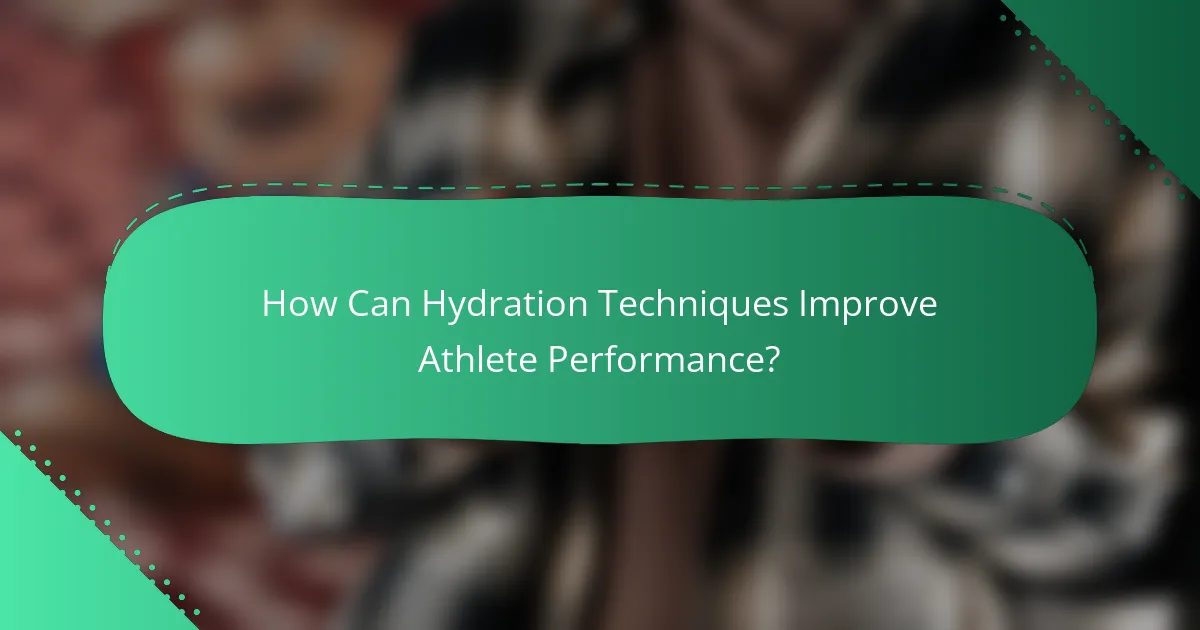
How Can Hydration Techniques Improve Athlete Performance?
Hydration techniques can significantly enhance athlete performance by maintaining optimal fluid levels and electrolyte balance, especially during intense physical activity. Proper hydration helps prevent fatigue, improves endurance, and supports recovery, making it essential for peak performance in sports.
Electrolyte balance
Electrolyte balance is crucial for athletes, as these minerals help regulate nerve function and muscle contractions. Sodium, potassium, magnesium, and calcium are key electrolytes that can be lost through sweat. Consuming sports drinks or electrolyte-rich foods can help replenish these minerals during and after exercise.
A general guideline is to consume beverages containing electrolytes when exercising for over an hour, particularly in hot conditions. This can help maintain performance and prevent cramping.
Fluid intake timing
Timing fluid intake is vital for optimizing hydration. Athletes should aim to hydrate before, during, and after exercise. Drinking water or electrolyte drinks 2-3 hours before an event can prepare the body, while sipping fluids every 15-20 minutes during activity helps maintain hydration levels.
Post-exercise, rehydrating within 30 minutes can enhance recovery. A good rule of thumb is to drink about 1.5 liters of fluid for every kilogram of body weight lost during exercise.
Hydration strategies
Effective hydration strategies include setting specific hydration goals based on the duration and intensity of the activity. Athletes can use tools like hydration tracking apps or simple reminders to ensure they drink enough fluids throughout the day.
Incorporating hydrating foods, such as fruits and vegetables, can also contribute to overall fluid intake. Foods like watermelon and cucumbers can be particularly beneficial.
Personalized hydration plans
Creating personalized hydration plans involves considering individual sweat rates, exercise intensity, and environmental conditions. Athletes should monitor their hydration needs and adjust fluid intake accordingly.
Consulting with a sports nutritionist can help tailor hydration strategies to specific needs, ensuring optimal performance and recovery. Factors such as body weight, climate, and training schedule should all be taken into account.
Impact on recovery
Proper hydration plays a significant role in recovery after exercise. Adequate fluid intake helps reduce muscle soreness and fatigue, facilitating quicker recovery times. Hydration supports metabolic processes that repair muscle tissue and replenish energy stores.
To optimize recovery, athletes should focus on rehydrating immediately after exercise and throughout the day. Combining fluids with carbohydrates and protein can further enhance recovery outcomes.
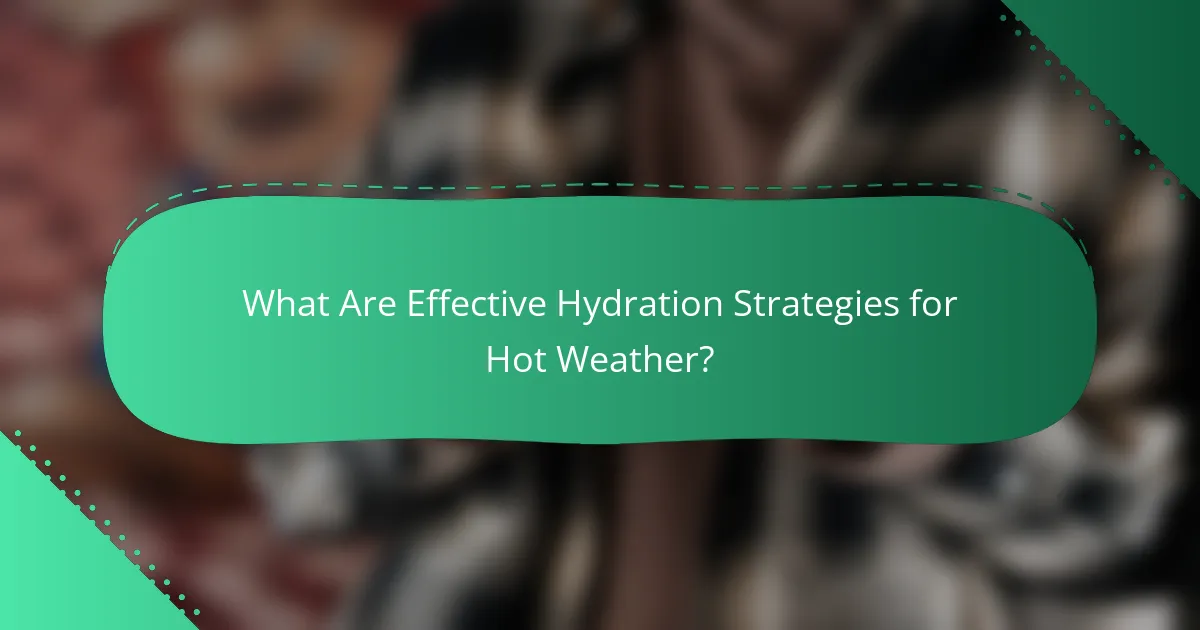
What Are Effective Hydration Strategies for Hot Weather?
Effective hydration strategies for hot weather focus on maintaining fluid balance before, during, and after physical activity. Proper hydration helps athletes perform at their peak and reduces the risk of heat-related illnesses.
Pre-exercise hydration
Before exercising in hot conditions, athletes should aim to hydrate adequately. Consuming about 500-600 ml of water or a sports drink 2-3 hours prior to activity is recommended. This allows time for the body to absorb the fluids and helps ensure optimal hydration levels.
Additionally, monitoring urine color can be a practical way to assess hydration status. A pale yellow color typically indicates good hydration, while darker shades suggest the need for more fluids.
During-exercise hydration
During exercise in hot weather, it’s crucial to replace fluids lost through sweat. Athletes should aim to drink about 200-300 ml of water or an electrolyte drink every 15-20 minutes. This helps maintain performance and prevents dehydration.
For activities lasting longer than an hour, consider drinks containing electrolytes to replenish lost sodium and potassium. Avoid overly sugary drinks, as they can lead to gastrointestinal discomfort.
Post-exercise rehydration
After exercising, rehydration is essential for recovery. Aim to consume 1.5 liters of fluid for every kilogram of body weight lost during the activity. This can include water, sports drinks, or even foods with high water content.
Incorporating electrolytes in post-exercise hydration can further aid recovery, especially after intense workouts. Consuming a balanced meal with fluids within 30-60 minutes post-exercise can enhance rehydration and replenish energy stores effectively.
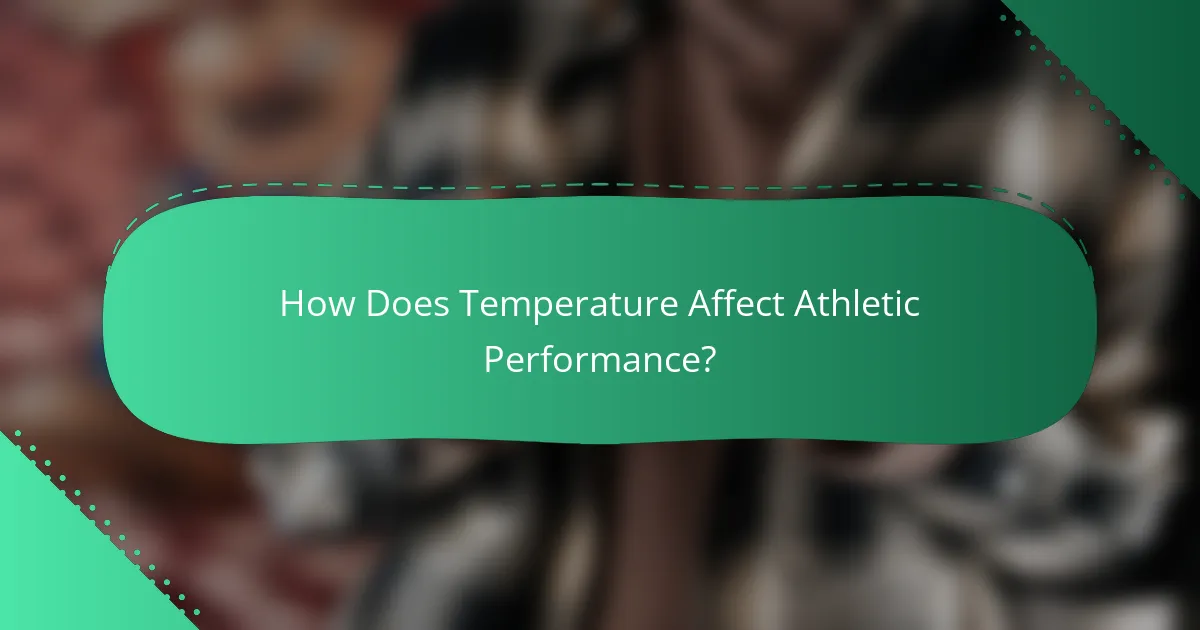
How Does Temperature Affect Athletic Performance?
Temperature significantly impacts athletic performance, as higher heat levels can lead to heat stress, affecting endurance and strength. Athletes must understand how temperature influences their bodies to optimize performance and prevent heat-related illnesses.
Heat stress impact
Heat stress occurs when the body cannot dissipate heat effectively, leading to increased core temperature and dehydration. This condition can impair physical and cognitive functions, resulting in fatigue, decreased coordination, and slower reaction times.
To mitigate heat stress, athletes should monitor environmental conditions and adjust their training intensity accordingly. Staying hydrated and taking regular breaks in shaded or cooler areas can help maintain performance levels during hot weather.
Performance decline thresholds
Performance typically declines when the temperature exceeds certain thresholds, often around 30-35°C (86-95°F) for many athletes. At these temperatures, the risk of heat-related illnesses increases, and endurance can drop significantly.
It’s crucial for athletes to recognize their personal limits and adjust their training or competition schedules to avoid peak heat times. Hydration strategies should be implemented well before reaching these thresholds to ensure optimal performance.
Heat acclimatization benefits
Heat acclimatization refers to the body’s physiological adaptations to prolonged exposure to high temperatures. This process can enhance sweat rate, improve cardiovascular stability, and lower the perceived exertion during exercise in the heat.
To achieve heat acclimatization, athletes should gradually increase their exposure to hot conditions over 1-2 weeks. This can involve training in warmer environments or using heat chambers, allowing the body to adapt and perform better under stress.
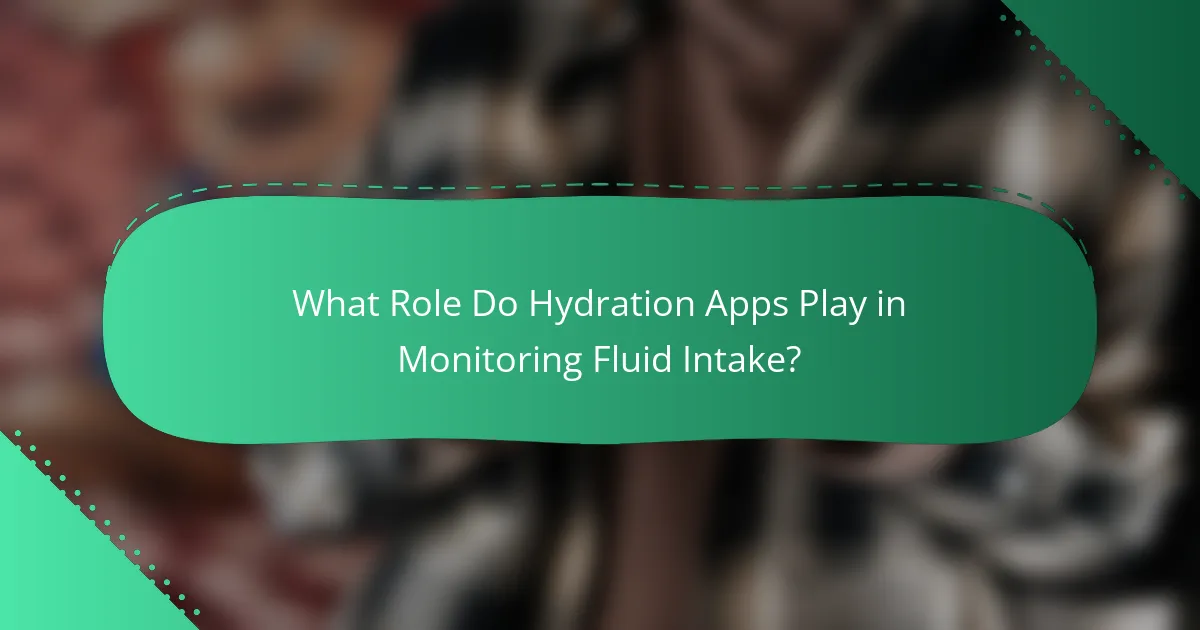
What Role Do Hydration Apps Play in Monitoring Fluid Intake?
Hydration apps are essential tools for athletes to track their fluid intake and ensure optimal hydration levels. By providing real-time data and personalized feedback, these apps help users maintain peak performance, especially in hot weather conditions.
Real-time tracking
Real-time tracking features in hydration apps allow athletes to log their fluid intake as they consume beverages throughout the day. This immediate feedback helps users stay aware of their hydration status and make adjustments as needed, particularly during intense training sessions or competitions.
Many apps utilize notifications to remind users to drink water at regular intervals, which is crucial for maintaining hydration levels. Athletes can set specific goals based on their body weight and activity level, ensuring they meet their daily hydration needs.
Personalized reminders
Personalized reminders in hydration apps cater to individual hydration needs based on factors like age, weight, and activity level. These reminders can be customized to alert users when it’s time to hydrate, which is especially beneficial during hot weather when fluid loss is heightened.
For example, an athlete might set reminders to drink a certain amount of water every hour or receive alerts after completing a workout. This tailored approach helps athletes develop consistent hydration habits, reducing the risk of dehydration.
Data analysis features
Data analysis features in hydration apps provide insights into hydration patterns over time, helping athletes understand their fluid intake trends. By reviewing this data, users can identify periods when they may not be drinking enough, allowing for proactive adjustments.
Some apps even offer visual representations of hydration levels, making it easier to see progress and stay motivated. Athletes can compare their hydration habits with performance metrics, helping them make informed decisions about their training and recovery strategies.
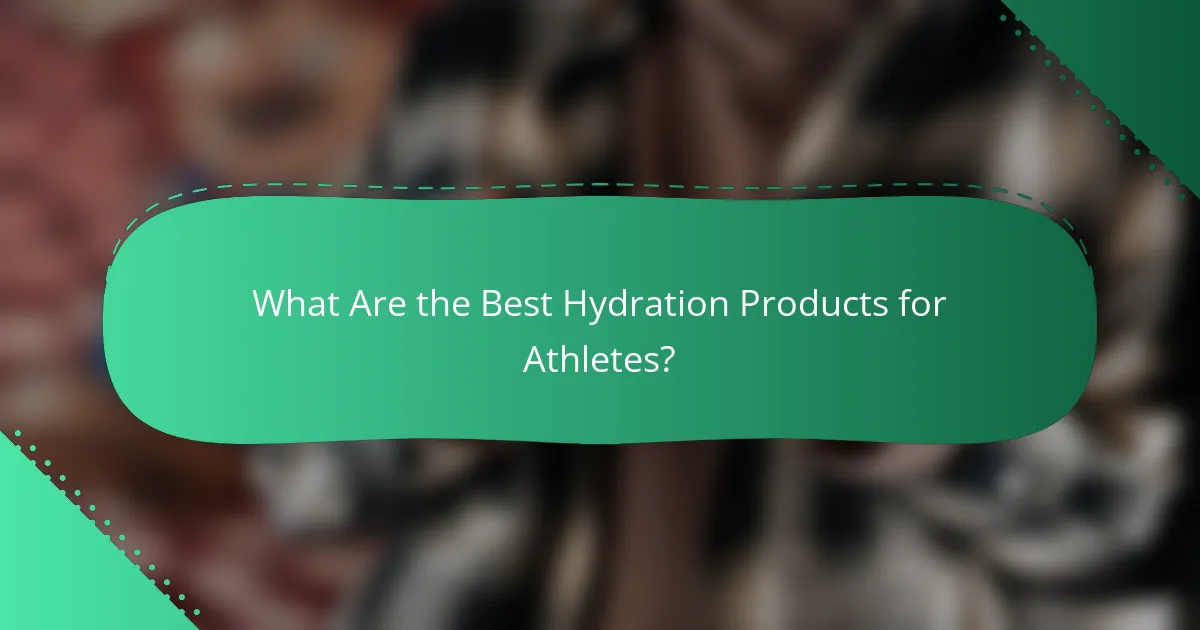
What Are the Best Hydration Products for Athletes?
The best hydration products for athletes include electrolyte drinks, water bottles with built-in filters, and hydration tablets. These products help maintain fluid balance, replenish electrolytes lost during exercise, and ensure athletes stay hydrated, especially in hot weather.
Electrolyte Drinks
Electrolyte drinks are essential for athletes as they replenish vital minerals like sodium, potassium, and magnesium lost through sweat. Look for options with a balanced ratio of electrolytes and carbohydrates to optimize performance. Popular brands often provide drinks with around 6-8% carbohydrates, which can enhance hydration and energy levels.
When choosing an electrolyte drink, consider the sugar content and artificial ingredients. Low-sugar options are preferable for prolonged activities, while flavored varieties can encourage consistent hydration during training sessions.
Water Bottles with Built-in Filters
Water bottles with built-in filters are convenient for athletes who need access to clean drinking water on the go. These bottles can remove impurities and improve taste, making it easier to stay hydrated during workouts or competitions. Look for models that can filter out bacteria and chlorine, ensuring safe drinking water.
Consider the size and portability of the bottle. A capacity of around 500-750 ml is ideal for carrying during runs or cycling, while lightweight materials make it easier to transport without adding extra weight.
Hydration Tablets
Hydration tablets are a compact and convenient way to enhance water intake. They dissolve in water and typically contain electrolytes and vitamins, making them a great option for athletes who prefer a flavored drink without the calories of traditional sports drinks. Most tablets are designed to be added to about 500 ml of water.
When selecting hydration tablets, check for sugar content and the presence of artificial additives. Many athletes prefer effervescent tablets for their refreshing taste and quick absorption, especially during intense training or hot weather conditions.


